Using Fiscal Years and Weeks (OnePager Pro)
Contents
About Fiscal Years and Weeks (OnePager Pro)
OnePager has date formats for both calendar-year and fiscal year representations. ”Date labels” are represented in a standard way for any task/milestone or decoration that has a date association. These include:
- Tasks/Milestones start and finish dates
- Baseline start and finish dates
- Deadline date
- Endpoint (4 in total) date
- Time axis levels (3 levels) dates
For all but the time axis levels, you have the capability to specify the position of dates with respect to the task, milestone, or decoration. For all of the above, including time axis levels, you may specify the font properties of the date text as well.
Tasks/milestones and their associated decorations (baselines, deadlines, and endpoints) have their date label characteristics specified globally following the steps outlined below:
- a) Select the “Project-View Properties” button on the OnePager “Home” ribbon.
- b) This will bring up the “Project-View Properties” form where you may select either the “Task Bar” tab or the “Milestone” tab to gain access to the appropriate “decorations” section of the form as shown below:
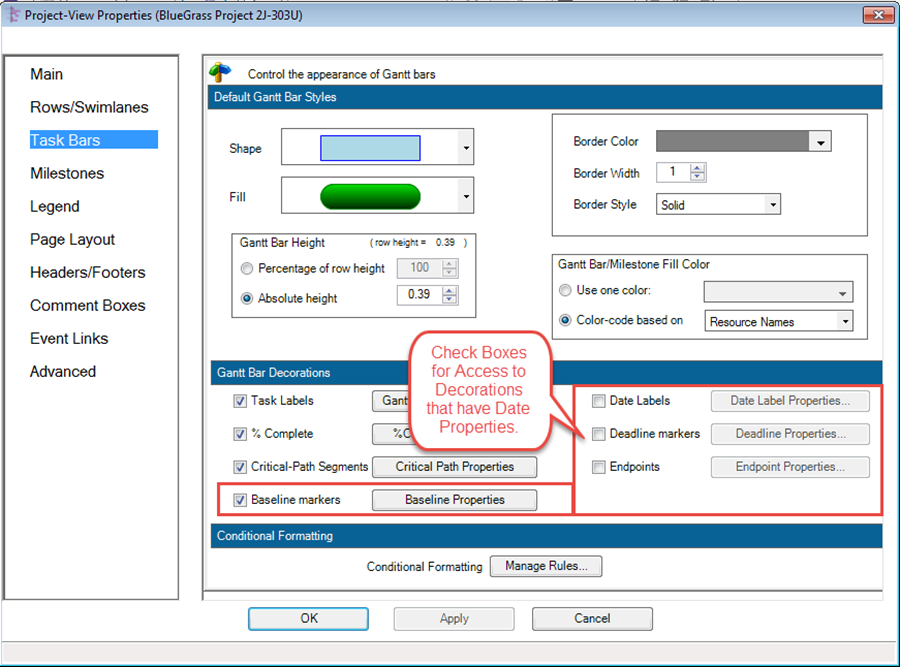
- c) When any “decoration” check box is checked, you may click the associated “Properties” buttons to the right to gain access to the respective “Change marker properties” forms as with the example for “Baseline Properties” below:
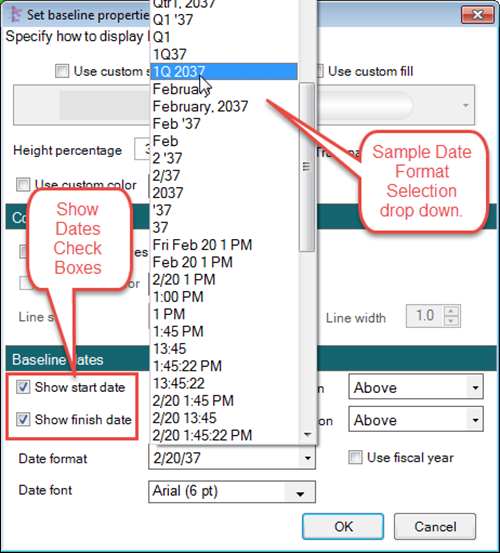
- d) The form above shows typical “dates” control groups for a “Set --- properties” form. Choosing to show the dates, the positioning of the dates, the selection of the date format, and date font properties are standard throughout OnePager.
Using Fiscal Years
The “Use fiscal year” check box, however, requires some further explanation. When this check box is checked, OnePager expresses years, quarters, month number of the year, week number of the year, and day number of the year relative to the start of the fiscal year.
- a) As an example, suppose we have the following simple one task project with the single task spanning two standard calendar years. The Microsoft Project plan will look like this:

- b) Creating the project view will yield this project view where the time axis is specified globally as a standard calendar year, the single Task’s Start date is shown above the task and its Finish date is shown below:

- i) The years shown for the Task’s Start date is shown as 2014 and the Task’s Finish date is shown as 2015 above. This matches the time axis specification.
- ii) If we now use the time axis controls accessed through the “Main” tab of the “Project-View Properties” form, click the “Configure time axis” button in that tab, and go to the various tabs we can change the time axis to reflect a fiscal year type format with the beginning of the fiscal year in October, let’s say, and the name of the fiscal year will be specified in the calendar year that the fiscal year ENDS. After resetting the “Top”, “Middle” and “Bottom” tabs in the “Advanced time axis features” form to represent the conditions stated above, we can make changes to the “Advanced” tab control as shown below:
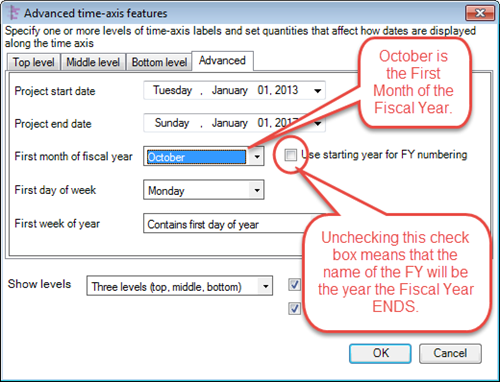
- iii) Configured with these time axis control settings, the above project view is transformed to look like this:
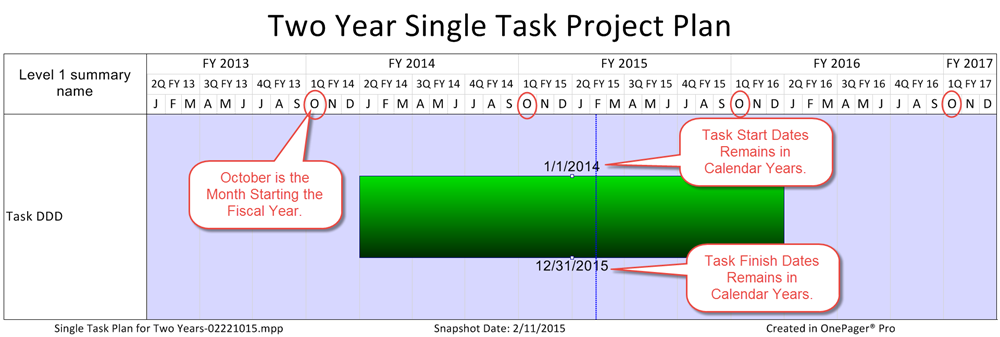
- iv) Since we would like to have the Task’s Start and Finish dates to reflect the correct fiscal year designation, we need to make two more adjustments. First, we need to check the “Use fiscal year” check box in the “Set date properties” form accessed through the “Task Bar” tab of the “Project-View Properties” form and the “Date Label Properties” button to get to the form shown below:
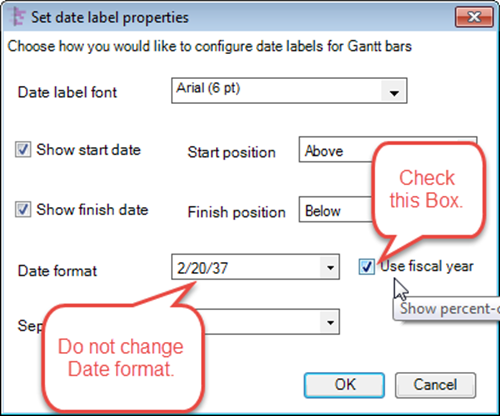
- v) In the above illustration, the “Use fiscal year” check box is checked but we have not changed the date format, which is the second change that will have to be made. The first change will look like this:

- vi) To avoid a possible misunderstanding on the duration of the task in the example above, we recommend, if year must be displayed, that it be displayed in a format clearly showing the fiscal year nature of the Task’s Start and Finish dates as shown below:
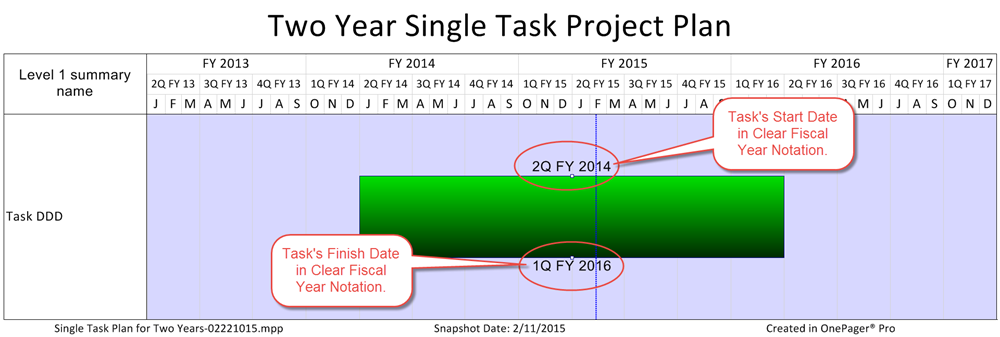
Using Fiscal Weeks
OnePager is able to display the week number of each fiscal year, going sequentially from 1 to 52 (or 53 in some cases). The feature is discussed below and some of the results are shown.
This feature depends on your answer to three questions in setting up the time axis:
- a) On what day of the week does each week start (Sunday, Monday, etc.)?
- b) Which month is the first month of the fiscal year?
- c) Is the first week of the fiscal year the first full week, or is it the week that contains the first day of the fiscal year?
The following illustrations define weeks as beginning on Sundays and define the fiscal year as beginning in October. These are the two cases of setting the answer to the third question above to make sure that the feature reflects your desires. The examples show how to answer the three questions via the “Advanced time-axis features” form.
These examples will display all three levels on the OnePager time axis. The top level shows FY and month. The middle level shows week of the fiscal year, the main concern. The bottom level shows day of the week.
Here is how to set up the second level of the time axis to display weeks of the fiscal year.
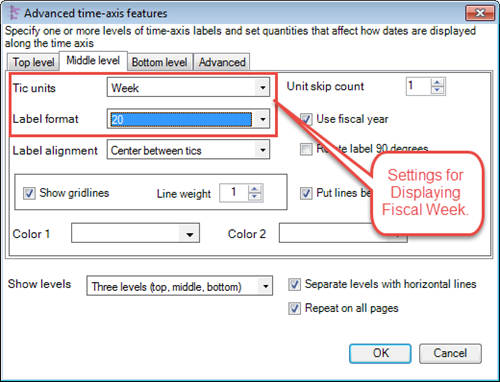
Clearly this example will result in a bottom time axis (days) that are too crowded to be properly displayed. When OnePager detects this condition, it provides a warning message as shown below:
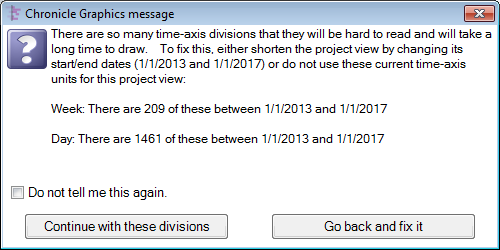
Under such circumstances it is recommended that you adjust your time axis level selections to present a more pleasing display of the time axis.
First Week of the Fiscal Year Contains the First Day of the Fiscal Year
The settings in the “Advanced” tab tell OnePager to count fiscal year weeks from the week that contains the first day of each fiscal year. (The form below also shows how to establish Sunday as the first day of the week and October as the first month of the fiscal year.)
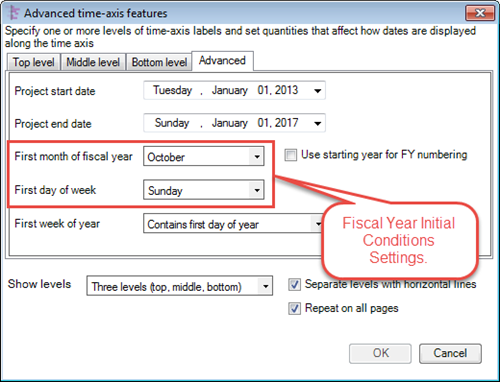
The result of these settings is shown below. The first week of fiscal year 2014 begins on Sunday, September 30th of calendar year 2013 which is the week that contains the first day of fiscal year 2014 (Monday, October 1st of calendar year 2014).

First Week of the Fiscal Year is First Full Week of the Fiscal Year
The settings shown below in the “Advanced” tab tell OnePager to count fiscal year weeks from the first full week of each fiscal year.
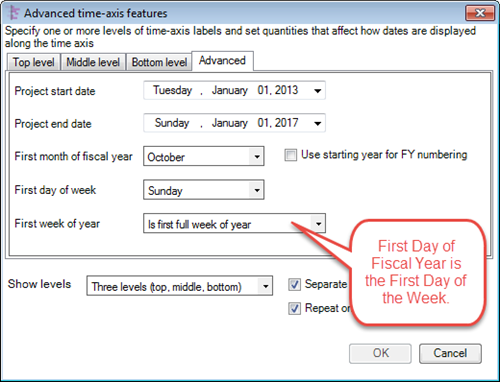
And below is a project view time axis which correctly shows the first week of fiscal year 2013 beginning on Sunday, September 30th of calendar year 2012, which is the week that contains the first day of fiscal year 2013 (Monday, October 1st of calendar year 2012).

(22.2)